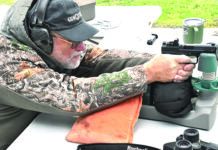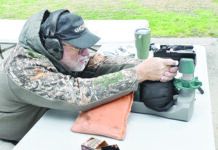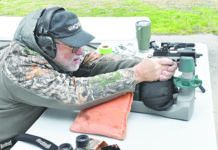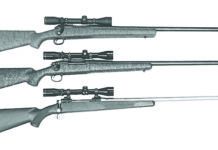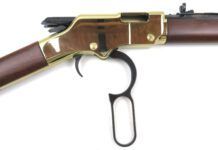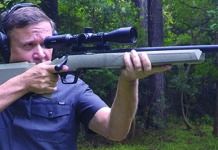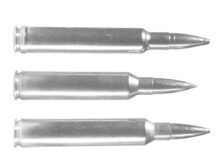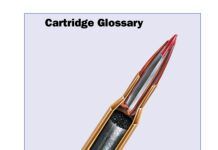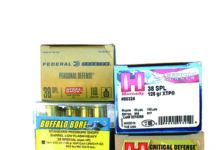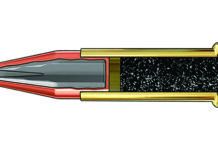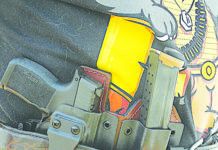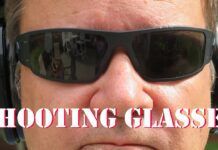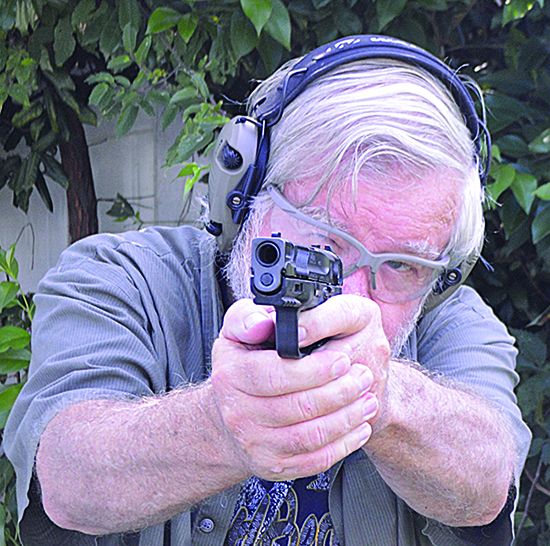The compensated 9mm seems more popular than ever, with Smith & Wesson, Springfield, and SIG offering pistols with compensators on the end of the barrel, mounted integrally in the slide, or as a simple cut out in the barrel. Most of us don’t consider the 9mm to be a hard kicker. Just the same, the addition of a compensator seems to be an important trend. Another movement finding favor is manufacturing a handgun with an aluminum frame as an alternative to the usual polymer-frame 9mm. The additional weight results in less recoil. In either case, the difference in speed shooting is noticeable because recoil is less.
In this shoot out we fire two innovations against each other. The first is Smith & Wesson’s Military & Police 2.0 Compact Performance Center gun. This is a polymer-frame compact 9mm with an integral compensator. Next is the Live Free Armory Compact AMP, short for Aluminum Match-Grade pistol. This is a Glock 19–size handgun with a 15-round magazine capacity. The AMP is also available in a long-grip AMPX version, which accepts 17-round magazines. The Live Free Armory AMP is similar to the Glock pistol, being basically a metal-frame 9mm version of the Glock 19 with certain innovations.
We have fired dozens of 9mm handguns, and we can say the pistols tested here are in fact light in perceived recoil and high on recoil-recovery control. We found one to be more comfortable to fire, while the other was faster in making follow-up shots. In the end, one pistol has the better features, while the other is a good pistol, but it’s not the top performer in this shoot out. Here’s how they did:
Smith & Wesson Performance Center M&P9 M2.0 Compact Carry Comp 13989 9mm Luger,
$788
Gun Tests grade: A
This is a good pistol with interesting upgrades. Light, reliable, and good shooting in rapid fire despite its light weight, the M&P pistol provided excellent performance. Only a heavier and more expensive handgun is likely to outshoot this piece. The compensator does what it is designed to do.

| Action | Semi-auto short recoil, locked breech striker fired |
|---|---|
| Trigger | Striker-fired double action only |
| Overall Length | 7.25 in. |
| Overall Height | 5.0 in. |
| Maximum Width | 1.275 in. |
| Weight Unloaded | 1.58 lbs. |
| Weight Loaded | 1.98 lbs. |
| Barrel | 4.22 in. long, stainless steel, compensated |
| Capacity | 15+1 |
| Slide | Black Melonite-finished stainless steel |
| Slide Retraction Effort | 14.5 lbs. |
| Frame | Polymer |
| Frame Front Strap Height | 2.0 in. |
| Frame Rear Strap Height | 3.0 in. |
| Grip | Black polymer, removable inserts |
| Grip Thickness | 1.1 in. |
| Grip Circumference | 5.5 in. |
| Front Sight | Tritium dot |
| Rear Sight | U notch |
| Optics | C.O.R.E. System |
| Trigger Pull Weight | 4.5 lbs. |
| Trigger Span | 2.5 in. |
| Magazines | (2) 15 round |
| Warranty | Lifetime |
| Telephone | (800) 331-0852 |
| Website | Smith-Wesson.com |
| Made In | U.S. |
This pistol is the long-serving Military & Police model with 2.0 upgrades and a compensator. We have tested many S&W M&P variations and have found them to be pistols with ergonomics superior to most other polymer-frame striker-fired handguns. This pistol is built on the compact or C-frame variation. The M&P slide is nicely finished with a black-nitride treatment. The forward and rear cocking serrations are done with what one young rater called bling. The serpentine serrations offer plenty of gripping surface. The forward cocking serrations extend lower on the slide than most. The slide features a total of seven lightening cuts, three on each side of the slide and another on the top of the slide. There is an additional cut out for the compensator. The end of the slide is squared off more than the LFA pistol, and the barrel crown is good, but not custom grade like on the AMP. The front sight is a post type with a tritium insert. We liked the tritium for dim-light work. The fiber-optic LFA sight is brighter in open-air range work. The rear sight at first look seems identical to the LFA sight. However, the Smith & Wesson rear sight features a U notch rather than the square rear notch of the LFA. The LFA pistol sights may be geared more toward accuracy work, while the Smith & Wesson sight leans more toward fast combat-shooting work. The slide features the C.O.R.E. optics-mounting system for red-dot sights. The pistol features a Performance Center logo on the left-hand side of the slide.
While our example is a polymer-frame handgun, a metal-frame pistol is also available. Affordability and lighter weight led us to this pistol over the metal-frame S&W. The frame features a light rail for mounting combat lights. The pistol features ambidextrous slide lock/release controls. The S&W also features a lever-type takedown we prefer strongly to the Glock push-button lever-type takedown. It is easier to use and more positive in operation. The long angular magazine release is positive in operation. The M2.0 series features a flat trigger, which is much improved over the original S&W-type trigger. This trigger breaks cleanly, more so than the average M&P. The Performance Center pistol features a sharp break of 4.5 pounds and a clean trigger reset. We found this trigger superior to the LFA AMP 9mm pistol.
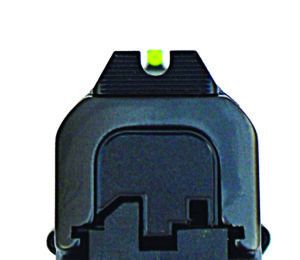
The grip-frame treatment is well done, with a balance of adhesion and abrasion that provided a clear advantage in firing the pistol. The M&P is also supplied with grip inserts. The Smith & Wesson system is simple: Remove a tool and twist the tool in the frame to allow changing the grip insert. The pistol is supplied with two 15-round magazines. In common with the Glock-based LFA pistol, the M&P accepts higher-capacity magazines, including the 23-round Smith & Wesson magazine. They simply protrude from the base of the grip. The S&W is delivered with two magazines, each being the 15-round compact type. There is a neat zippered tool kit/cleaning kit, three grip inserts, and a gun lock. An optional magazine well and gun lock are included. The box is cardboard versus the LFA’s zippered case, but the S&W has more accessories.
On the firing line, we concentrated on accuracy potential and recoil control. The S&W is a soft shooter by any standard, but we detected more recoil than with the heavier LFA pistol. However, the S&W shot flatter. What that means is that muzzle flip is subdued. The pistol really gives a trained shooter an edge in maintaining control in rapid-fire shooting. Firing two shots quickly at 7 yards, really shows the advantage of the Carry Comp handgun. If we divide combat competency into tiers, the LFA outshoots many striker-fired pistols in control. We think the S&W is even more controllable, but it takes a trained shooter and a few rounds to demonstrate the advantage.
The sights of the S&W, with a U-notch rear and tritium front, are better suited to rapid acquisition of the target in personal defense, we believe. The S&W gave good to excellent results in combat shooting. In recent memory, two 9mm handguns that are both more controllable than these two are the S&W 9mm SPEC, which uses a metal frame and a compensator, and the SIG P320, also a metal-frame compensated pistol. Each are larger, heavier, and more expensive than our test guns, however.
In benchrest fire, we tested the S&W M&P 2.0 Performance Center Carry Comp with the same three loads as the LFA pistol. Results were good, with some groups as small as 2.0 inches, very good for a polymer-frame striker-fired pistol. Also in this stage of the comparison, we fired both pistols in a left-hand drill. We had no problems in firing either pistol, but handling was another matter. The Smith & Wesson features an ambidextrous slide lock that the LFA lacks. Also, the S&W magazine release is easily reversible. The Smith & Wesson comes out ahead on this score.
Our Team Said: We liked the S&W Compact Carry Comp M2.0 9mm, finding it to be a good gun for personal- or home-defense use. The S&W is reliable, came out on top in both combat shooting and absolute accuracy, and it isn’t too expensive for most budgets. Features like those on the AMP count, but, most important, only one of these handguns is reliable — the Carry Comp. Also, we learned that the Smith’s barrel compensator is more helpful than the AMP’s heavier frame in maintaining control on the target. Elsewhere, the S&W’s frame treatment is superior to the AMP’s, and the S&W Carry Comp’s forward cocking serrations are true serrations rather than the lightening cuts on the LFA. The S&W has more room to modify handfit, and the S&W has better adhesion and abrasion out of the box. The Smith & Wesson trigger is superior to most striker-fired guns. In the end, we feel that the S&W Performance Center Compact Carry Comp pistol is worth the money compared to a standard M&P, or to the LFA AMP.
| 9MM LUGER RANGE DATA | ||
|---|---|---|
| Federal Syntech Range 115-grain TSJ | Live Free Armory AMP Compact | Smith & Wesson 2.0 Carry Comp |
| Average Velocity | 1110 fps | 1134 fps |
| Muzzle Energy | 315 ft.-lbs. | 328 ft.-lbs. |
| Smallest Group | 2.6 in. | 1.9 in. |
| Average Group | 3.2 in. | 2.2 in. |
| Hornady Critical Duty 135-grain FlexLock | Live Free Armory AMP Compact | Smith & Wesson 2.0 Carry Comp |
| Average Velocity | 1060 fps | 1065 fps |
| Muzzle Energy | 337 ft.-lbs. | 340 ft.-lbs. |
| Smallest Group | 2.4 in. | 1.8 in. |
| Average Group | 3.0 in. | 2.5 in. |
| Speer Gold Dot 124-grain GDHP | Live Free Armory AMP Compact | Smith & Wesson 2.0 Carry Comp |
| Average Velocity | 1120 fps | 1139 fps |
| Muzzle Energy | 345 ft.-lbs. | 357 ft.-lbs. |
| Smallest Group | 2.0 in. | 1.9 in. |
| Average Group | 2.5 in. | 2.3 in. |
We fired groups at 25 yards from a bench rest using an MTM Case-Gard K-Zone Pistol Rest. We used a Competition Electronics Pro Chrony to measure velocities. The first screen of the chronograph was 10 feet from the muzzles. TSJ = Total Synthetic Jacket. GDHP = Gold Dot Hollow Point.
Written and photographed by Bob Campbell, using evaluations from Gun Tests Team members. GT


